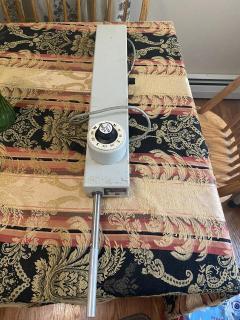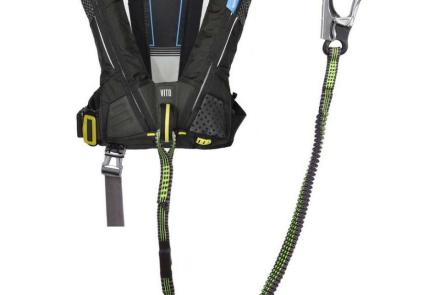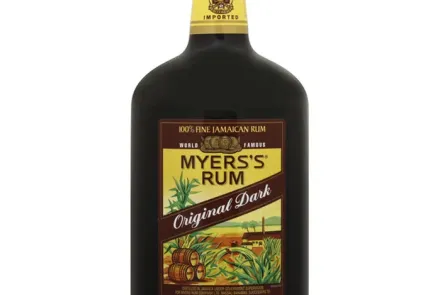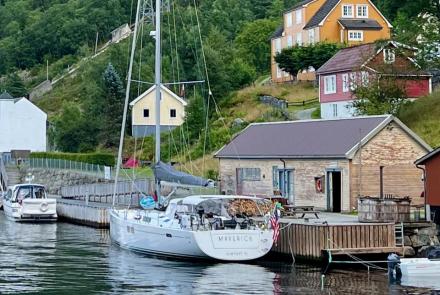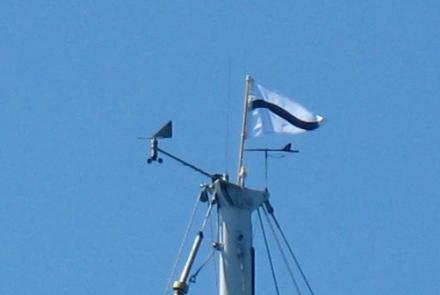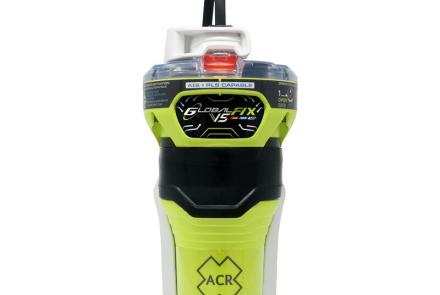The Errant Autopilot
“From the CCA School of Hard Rocks
...lessons learned in pursuit of the Art of Seamanship”
By Chuck Hawley, San Francisco Station, August 1, 2023
I sailed in the second annual Singlehanded Transpac in 1980 aboard my Moore 24, Slim, a sleek ultralight sloop built in Santa Cruz, that weighed about 2050 pounds and had barely sitting headroom when I went below. Moore 24s were known to be highly seaworthy, having been proven in numerous races down the windy California coast, and at least one had been double-handed to Hawaii from California. In the 1980 race, three Moores, all bright yellow, were competing in the 2070 nm race.
I purchased a newly-introduced Autohelm 2000 tiller autopilot for the race which was dramatically different from autopilots that had been on the market. The drive unit looked like a sleek hydraulic cylinder, about 1 ¼ inches in diameter, connected to a compass and electronics cylinder about the size of a large jar of mayonnaise. The entire package was able to steer a boat in the 35’ range, and only consumed about half an amp.
The race got off to a brisk start, and soon I was broad-reaching along the California coast, angling offshore towards my eventual landfall on the north shore of Kauai: Hanalei Bay, one of the most picturesque places in the world. As the summer sky grew darker on that first night, I began to have a slight feeling of dread, alone on a very large and increasingly rough ocean, with my trusty Slim getting tossed around by the Pacific swells, and a touch of seasickness becoming more apparent.
Around midnight, I tried to get some fresh air by standing up in the companionway, listening to the steady purr of the autopilot as Slim surfed down the swells. This required a lot of rudder movement due to the following seas, but the trusty autopilot kept sawing back and forth, largely keeping me on course. A few minutes later, however, the familiar sound stopped, and the swing of the rudder and tiller came to a halt with perhaps 10 degrees of port rudder locked in. Before I could get to the tiller and lift the tiller pilot off its pin, the boat flew through an uncontrolled gybe which caused the mainsheet traveler car to bang into its stop on the starboard side that it failed to, uh, stop it as it continued off the end of the track, flinging its ball bearing wheels into the black water. The jib went aback, and pinned the boat in an unplanned hove-to maneuver, and the boat became suddenly quiet, especially the now nonfunctional autopilot.
My father, Mel, had insisted that I take his tiller pilot with me as a backup, but as children of wiser men tend to be, I was against the very idea of taking an archaic Tillermaster with me since I had a brand new Autohelm. But, desperate times call for desperate measures, so I turned on my small interior light and started to root around in my damp cabin, looking for the Tillermaster. I found it at some point, and crawled on deck to replace the sleek Autohelm with what appeared to be a farmer’s concept of what an autopilot should look like.
For 30 minutes, I scrambled around in the cockpit, removing the inoperative pilot and installing the Tillermaster. The entire time, I continued to be hove-to as I had no other option. Finally I plugged in the 12V cord to the Tillermaster, and it came to life around 0100 and began to bring the boat back on course as I trimmed the sails for Hawaii.
The next morning I took apart the Autohelm 2000 electronics assembly. It had a large compass knob on the top, and identical upper and lower halves that were held together by a couple of threaded fasteners. I removed the fasteners and poured out about half a cup of saltwater from the enclosure. How that much water was able to get past the seals and gaskets I would never figure out. What I could figure out, though, was that it was beyond repair less than 24 hours after the start of the race.
(Fast forward four days.)
Due to the dearth of weather information available to me, I awoke on the fifth day of the race in the calmest sea imaginable. Slim was absolutely motionless, with her sails hanging limply from their halyards. I retrieved a small can of pineapple juice from the rapidly warming freezer, and dropped its pull tab into 12,000 feet of indigo water. Looking over the side of Slim, I watched the shiny aluminum tab spin and spin as it descended down in the inky depths. After about two minutes, and while still able to see the tab continue to spin beneath the boat, I surmised that my boatspeed was, in fact, zero.
Off in the distance, however, I saw a tiny white triangle perched on the horizon about a mile away. I had apparently caught up with one of my competitors who was also stuck in the oceanic goo called the Pacific High. I went below and attempted to raise the vessel on my VHF. Amy Boyer, captain of the smallest boat in the fleet, responded. Her Wilderness 21, also built in Santa Cruz, was ahead of me, but I was sure I could overtake her due to my impressive sailing skills, or sculling skills, if need be.
As luck would have it, I caught a little zephyr and began to overtake her at about half a knot. Eventually, I pulled alongside her and chatted, as one does, when 700 miles from the nearest land. She reported that it was her birthday, and she was now 21 years old. This seemed to be the thing that Letters to Latitude 38 are made from, so I casually made my way to the leeward side of the cockpit so I could chat with her.
That was my undoing. As I passed under the tiller, I flipped the Tillermaster up in the air, whereupon it landed in the Pacific, trailing by its power cord. The power cord had a small polarized plug inline, much like you would have on a trailer for lighting. Seeing my first-to-finish race results fading rapidly, I leaned back to try to snag the autopilot before it pulled free, but the drag of the device in the water became greater than the friction of the electrical plug, and the Tillermaster pulled free and floated astern. In fact, it floated long enough to end up alongside Amy’s boat, whereupon she plucked it out of the water. Seawater poured out of the completely not waterproof enclosure.
After about a minute, she sailed up to my leeward side and handed the drenched autopilot back to me. All thoughts of celebrating Amy’s birthday, mid-Pacific, were replaced by the immediate issue of fixing the Tillermaster so that I would not have to hand steer for the next 1500 miles.
I started by removing the screws that held the case together. Using paper towels, I blotted and dabbed at all of the seawater that I could find clinging to the motor, circuit board, and other electrical components. I gave this effort about a 10% chance of working, since nothing inside the enclosure showed the slightest signs of being waterproof. Satisfied that I had done the minimum, I reassembled the autopilot and inserted one of my five spare fuses that I had brought along “just in case”. The fuses were the old glass automotive style, and I recall that they were 1.5 amp slow-blow so it was a tribute to the efficiency of the device that they were that sensitive, and a challenge to find all of the saltwater paths to ground that lurked inside. When I applied power to the pilot, it started happily running the actuator arm in and out for about two seconds, whereupon the fuse did what fuses are intended to do: it blew.
Apart came the pilot for the second time, this time with the addition of fresh water to flood all of the electrical components and rid them of any remaining salt. More paper towels, further disassembly, then reassembly, then the application of electricity. I think it ran for perhaps five seconds this time, then the new fuse blew. I continued with this process of taking the device apart doing what I could to flush the salt out, reassembling, and blowing fuses until I was on my last fuse. Well, not actually, as I had determined that I would wrap a fuse with aluminum foil if need be as my crowbar solution to the wimpy fuses.
The last fuse proved to be the one that worked, or at least I had “fixed” the Tillermaster sufficiently after several hours of trying it didn’t blow. By then, it was the afternoon, and Amy was no longer in sight. I broke out my ½ oz. spinnaker, and took advantage of the very breeze that blew towards Kauai. My daily run on that day was 29 miles, and according to the pilot chart, there was a ¾ knot current on my stern, so I actually sailed 11 miles and drifted 18. It was going to be a long trip to Kauai at that rate.
I did eventually cross the finish line in Hanalei after 18 days at sea, finishing 9th out of the 40 boats entered, and was the third of three Moore 24s to arrive. My father never let me speak negatively about Tillermasters again, and was quick to remind me of the benefits of redundancy.
Lessons learned:
1. Try new gear extensively before a voyage where you could be dependent on it.
2. Have more than one way to solve a problem. A wind vane would have been extremely helpful, for example. Even several pieces of shock cord could be pressed into service.
3. Seek the advice of others, and never roll your eyes at your father.


